






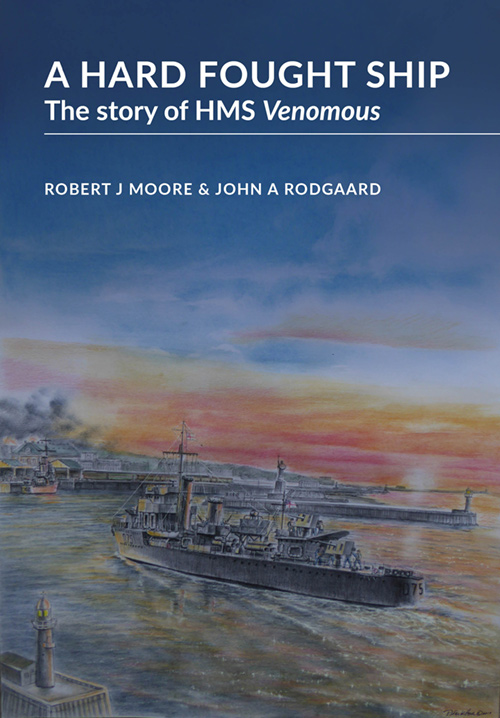
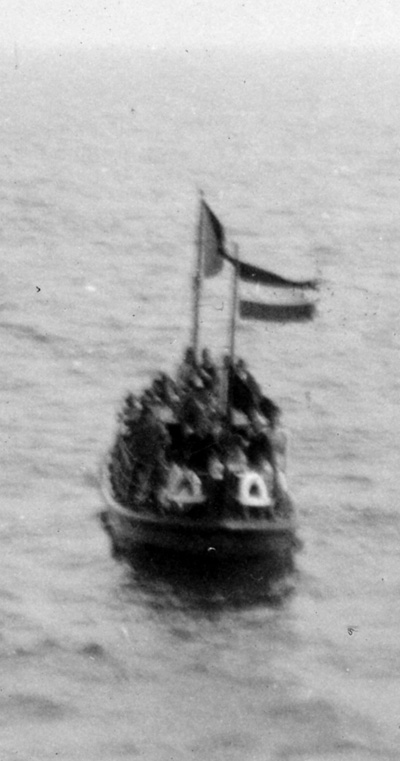 The phoney war came to a dramatic end in April 1940 with the occupation
of Denmark and Norway followed by the invasion of the Netherlands,
Belgium and northern France on the 10 May.
The phoney war came to a dramatic end in April 1940 with the occupation
of Denmark and Norway followed by the invasion of the Netherlands,
Belgium and northern France on the 10 May.
Venomous spent the first week of the German blitzkrieg on the Dutch coast. The Royal Family escaped to Britain aboard a Royal Navy Destroyer on the 13 May and
the surrender of all Dutch forces was broadcast at 6 pm the following
day. Dutch patriots wanting to continue the fight and Jews from Holland and
Germany were all looking for ways of escaping to
England.
On the 15 May HMS Venomous and a sister ship were escorting HMS Sandown and HMS Ryde, two requisitioned Southern Railways paddle steamers sweeping for mines near the Goodwin Sands when the
lookouts sighted a Dutch lifeboat, the Zeemanshoop - the Seaman's Hope - its decks crowded with refugees, men and women, flying a large Dutch flag and making distress signals. They were picked up and photographed on the deck of Venomous by Lt Peter Kershaw RNVR and landed at Dover that evening.
The refugees from Germany were interned on the Isle of Man as "enemy
aliens" but the Dutch refugees were welcomed to England and helped by the Netherlands Emergency Committee. The crew of four university students who saved the lives of the mostly Jewish passengers by hijacking the Dutch lifeboat served in the Dutch Navy and airforce and helped liberate their country.
The voyage of the Zeemanshoop and the story of its passengers and crew whose lives changed for ever when they left the small fishing port of Scheveningen on the day the Netherlands surrendered has an almost mythic status in the Netherlands but had they not been picked up by HMS Venomous they would have been swept down the Channel and into the Atlantic. Click on the links to read about the voyage of the Zeemanshoop and the lives of her passengers and to find out more about Venomous read A Hard Fought Ship.
The dramatic events of May 1940 are described in the new 480 hardback edition of
A Hard Fought Ship: the story of HMS Venomous
which was published on 9 May 2017
The book launch was held at the
Royal College of Defence Studies in London
Scheveningen - the only way out
The German invasion of the Netherlands began at 4 am on Friday 10 May with the bombing of an airfield south of Rotterdam followed by the dropping of parachutists. German troops were soon entering the southern outskirts of Rotterdam, the commercial heart of the Netherlands. The seat of government, The Hague, was twenty miles to the north west and Scheveningen, The Hague's main beach resort, had a large fishing harbour where the lifeboat, Zeemanshoop, was berthed.
By
Monday 13 May it was clear that the military situation was hopeless and that morning
Queen Wilhelmina left for England from the Hook of Holland aboard HMS Hereward. In the early hours of
Tuesday the 14 May the British Naval Attaché at The Hague, Admiral Sir Gerald L. Charles
Dickens with his assistants, Charles M. Morrell and Louden, arrived in
Scheveningen (the Hook of Holland was now in German hands) and the skipper of the Zeemanshoop, M.J. Bruin, took them out to a Royal Navy destroyer, HMS Malcolm, which they boarded under fire from German aircraft. The Zeemanshoop
returned to harbour safely.
A few hours later a party of fourteen Dutch
naval officers (including Vice-Admiral J. Th. Furstner) and five
members of a French military mission (including Général d'Armée
Mittelhauser) arrived at Scheveningen. They hoped to escape to England
on the Dutch torpedoboat Z-5. Half of them embarked on the Zeemanshoop and the remainder on the Johanna, a fishing boat, but the Z-5 did not turn up and they transferred to the Johanna which took them to Dunkirk while the Zeemanshoop returned to harbour.
I visited Scheveningen on the 8 May 2014 to see the place where these events took place. The present day lifeboat is moored in the same position as the Zeemanshoop in 1940 and it was easy to imagine the scene described below as the students hijacked the lifeboat and set off for England with 46 men and women aboard in calm weather but overladen and with a temperamental and unfamiliar engine. The families of the men and women who escaped to England on the Zeemanshoop celebrated the 75th anniversary of their voyage at a reunion in Scheveningen on the 14 - 15 May 2015.
The four university students hijacked the Zeemanshoop
on the evening of Tuesday the 14 May by breaking the padlock on the
hatch to the engine compartment but would not have succeeded in
starting the engine without the help of a fisherman engineer from
Scheveningen. The quayside was crowded with whole families, mostly
Jews, some Dutch and others refugees from Germany, all desperate to
escape death in the concentration camps. A soldier fired a warning shot
over the heads of those trying to board the overcrowded lifeboat and a
man fell in the water while making a desperate leap to join his family
and was hauled aboard as the final passenger before the Zeemanshoop chugged out of the fishing harbour at 21.00 hours and headed north west on course to England. Click on the link to read about the voyage.
The student crew wrote down the names of all those aboard the Zeemanshoop
on the back of an old chart during the voyage which has been widely reproduced (the chart itself in now in the regional archive of the department Noord-Holland in Haarlem).
Despite differences in spelling, the lack of forenames and married
women being merely appended to the names of their husbands as vrouw
(wife) this chart has been the key to tracing the families of those who
left the Netherlands to escape death in a concentration camp or if
young, male
and Dutch to join the fight to free their country. Marien de Jonge was a hundred when he died at The Hague
in July 2012 and at least two are
alive today. Karel Dahmen is a fit and active 96 year old who lives in
Austin,
Texas, and sculls on its lake with a crew of young women, and Loet
Velmans lives in the USA with his wife who survived the Holocaust to
write a best selling book about her experience. Click on the links to
read the stories of their lives.
Some were interned as "enemy aliens" and others welcomed as allies - "victims of aggresion"
The starting point for my research into the story of the Zeemanshoop was the photograph of its passengers on the deck of HMS Venomous
taken by Lt Peter Kershaw RNVR. They were smartly dressed and looked as
if they were on a theatre outing or going shopping rather than fleeing
for their lives. This photograph made me want to find out what happened
to them after they landed at Dover that evening - and in their
subsequent lives. Most
of them were Jews fleeing for their lives but their nationality
determined what happened to them after disembarking at Dover.
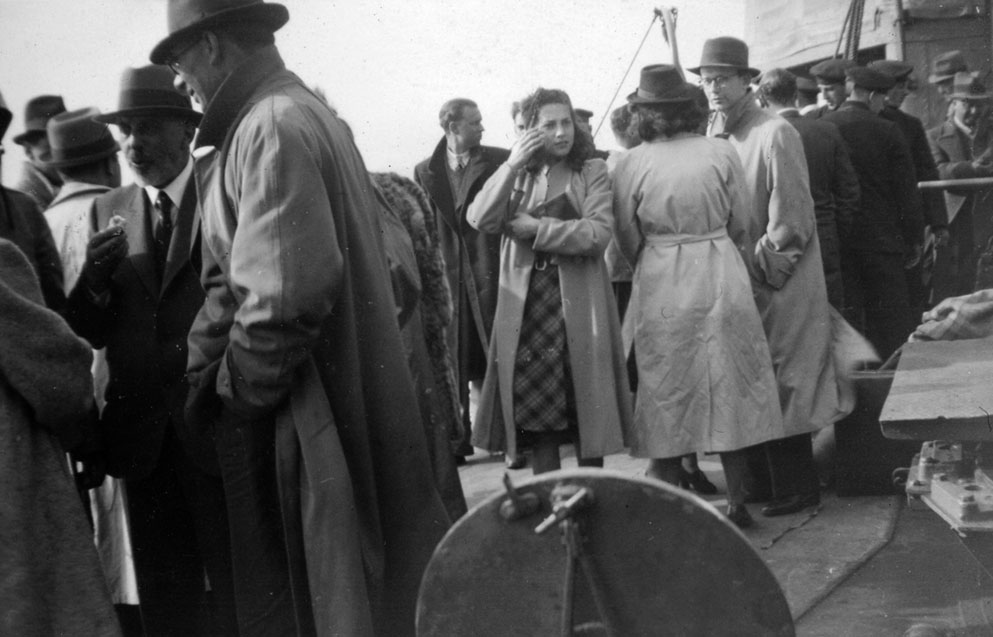
There is no certain means of knowing
how many of the passengers on the Zeemanshoop were Jews but it seems reasonable to assume
that where whole families left together they were Jewish
and although some would be of German nationality non would be Nazi
sympathisers.
The
Netherlands had remained neutral during the last war and many German
Jews thought it would be a safe haven. Between the Nazis coming to
power in Germany in 1933 and 1938 about twenty five thousand Jews left
Germany to seek refuge in the Netherlands. On arrival in Britain the
refugees from Germany were treated as enemy aliens and interned. Dutch women married to refugees from Germany were treated as Germans and interned along with their husbands. Even
Germans who had lived in Britain for fifty years but had not taken
British nationality were interned, including some whose sons were
serving in the armed services of their adopted country.
Some
of the Dutch passengers including Marien de Jonge who left behind his
wife and two week old son and the students who crewed the lifeboat were
not Jews and their only motivation for leaving their homes was to fight
for
their country. But where whole families left together, including women
and the elderly, it seems reasonable to assume that they were
Jewish.
There were about 140,000 Jews in the Netherlands before the war and around 75% were murdered, the highest percentage for any of the occupied countries of Europe. There were 80,000 in Amsterdam, about 10% of the population, but they did not all live in the old Jewish quarter. Unlike cities in many East European countries, Amsterdam never had a real Ghetto. The Jews were better educated and had more opportunities (e.g. in the diamond industry) and as they became more prosperous, like most Amsterdam citizens, they moved into better houses in other parts of the city or to towns and suburbs throughout the Netherlands. Some were only token Jews, celebrating the major festivals but living like their Christian neighbours. They had followed developments in Germany with growing anxiety and knew what to expect when they heard the news of the surrender broadcast on Dutch radio. The first thing the Nazis did after occupying the Netherlands was to concentrate the Jews in the centre of the city so that control became easier. The Jews with Dutch nationality were also keen to serve their country by joining the armed services or if too old to fight in some other capacity.
Regardless of their religion the Dutch refugees, our allies and victims of Nazi aggression, were welcomed and provided with accommodation in hotels and hostels and offered other practical assistance by the Netherlands Emergency Committee.
The Students
The four students who hijacked the Zeemanshoop and took it to England were young and single. They were what the Dutch came to call Engelandvaarders,
English Travelers, men who left their country in order to continue the
fight against the Nazi invaders. The oldest was Harry Hack and he was
the only one who was studying mechanical engineering and had any
experience of marine engines. There seems little doubt that they would
not have got far without him. He assumed command from the outset and
was recognised by the others as their captain. Harry Hack, Karel Dahmen
and Jo Bongaerts were all students at Delft University. Karel Dahmen
and Jo Bongaerts came from the same town and had been friends long
before they went to university. Lou Meijers was a first year medical
student at Groningen.
On
arrival in England all four tried unsuccessfully to join the remnants
of the Dutch armed services which had escaped to England.They found there was no demand for untrained volunteers and they
all spent periods serving on Dutch merchant ships which were at sea
when the Netherlands surrendered and headed for London. Karel Dahmen
was later commissioned in the Royal Netherlands Navy and was stationed at the
Dutch Liason Office at the Admiralty before serving with the Dutch MTB
Flotilla at Dover and being given command of the engineering company of
the Dutch Marine Brigade attempting to pacify the Dutch East Indies.
Lou Meijers flew spitfires with 322 Squadron of the RAF, the famous
Dutch Squadron. Karel's friend, Jo Bongaerts,
learned to fly at the Surabaya naval air station in the Dutch East
Indies but was retrained as a navigator by the RAF and flew Mitchell
B25 bombers with 320 Squadron. He was seriously injured when his
plane crash landed after a bombing raid for which he was awarded the
DFC but retrained to fly as second pilot on bombing raids with the
Tactical Air Force (TAC) over France and the Netherlands. Harry Hack
was commissioned in the Royal Netherlands Naval Air Service
and posted to its base at Surabaya shortly before the surrender of
Dutch forces in the East Indies. On his return to Britain via Ceylon he
served as an engineering officer with 320 Squadron.
The lives of the passengers and student crew
Click on the link and check the name index.
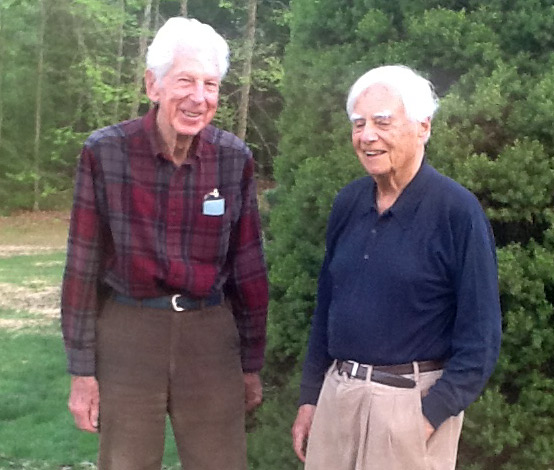 Karel Dahmen, the only member of the crew of four university students alive (on left), and Loet Velmans, a 17 year old high school student in 1940 (right), met on the 9 May 2013 for the first time since they disembarked from HMS Venomous
at Dover on the 15 May 1940. They both attended the reunion at
Scheveningen on 14 May 2015 but sadly Loet Velmans died on 11 November
2016. Karel Dahmen was 101 when he died on 16 February 2021.
Karel Dahmen, the only member of the crew of four university students alive (on left), and Loet Velmans, a 17 year old high school student in 1940 (right), met on the 9 May 2013 for the first time since they disembarked from HMS Venomous
at Dover on the 15 May 1940. They both attended the reunion at
Scheveningen on 14 May 2015 but sadly Loet Velmans died on 11 November
2016. Karel Dahmen was 101 when he died on 16 February 2021.
Karel
served in the Dutch Navy but Loet's family moved to the Dutch East
Indies where he could continue his interrupted education but he was
conscripted, captured by the Japanese and spent three dreadful years as
a POW working on the Burma - Siam railway. They live today in the USA
but occasionally return "home" to the Netherlands.
There are unlikely to be any others amongst the passengers on the Zeemanshoop still alive but the Zeemanshoop has been restored and is the main exhibit at the Lifeboat Museum on Amland.
Some of the passengers whose names were written on the reverse of the sea chart during the voyage have yet to be traced:
Jacob Meier / Meyer (described by Harry Hack in his memoir as a
"Koopman in London"), Meuleman and wife, Singer, Van Wezel, a family of
three women and one man named Von Arnheim / Aruheim (or perhaps Von
Stroheim) and
a Czech with the name P. Zaitschek (or, perhaps, Zaitichek / Zaitichik).
They may have remained in England, returned to the Netherlands or emmigrated to Israel, Australia or the USA. I would like to offer them - or their families - the chance to tell their stories on this web site and, perhaps, like Karel Dahmen and Loet Velmans the possibilty of meeting others who escaped from the Netherlands aboard the Zeemanshoop on the day the country's surrender was broadcast on Dutch radio.
What happened to the Zeemanshoop?
After its passengers and crew boarded HMS Venomous the Zeemanshoop
was taken to Ramsgate by AB Harold Knapton and a small crew from HMS Venomous. The belief that she assisted in the evacuation of troops from Dunkirk
was found to be false. While the evacuation was in progress the Zeemanshoop was
being taken along the south coast via Dover to Falmouth by Ltz. I Dirk van Beusekom KMR OV of the Royal Netherlands Navy assisted by three young midshipmen. Lt Beusekom
enjoyed the voyage and described it in his journal but it is a
pity that while the lifeboats of the RNLI were fully involved the Zeemanshoop took no part in the largest evacuation of troops from enemy soil ever attempted.
The Zeemanshoop became a communications launch for the Dutch Navy's
minesweepers at Holyhead, Anglesey, and at Harwich on the south east coast of England and when the war ended she
was returned to the Netherlands and worked with the minesweepers at
Teschelling. Her engine was in a ruinous state and the mechanics renamed the lifeboat the Seamen's Despair. She was restored by the Dutch Navy and returned to the KNRM and remained in service until 1976.
Astonishingly, the Zeemanshoop is still afloat and has been bought by a a Foundation and restored her to her prewar appearance and brought to Sceveningen for the reunion of the families on the 75th anniveresary of the voyage.
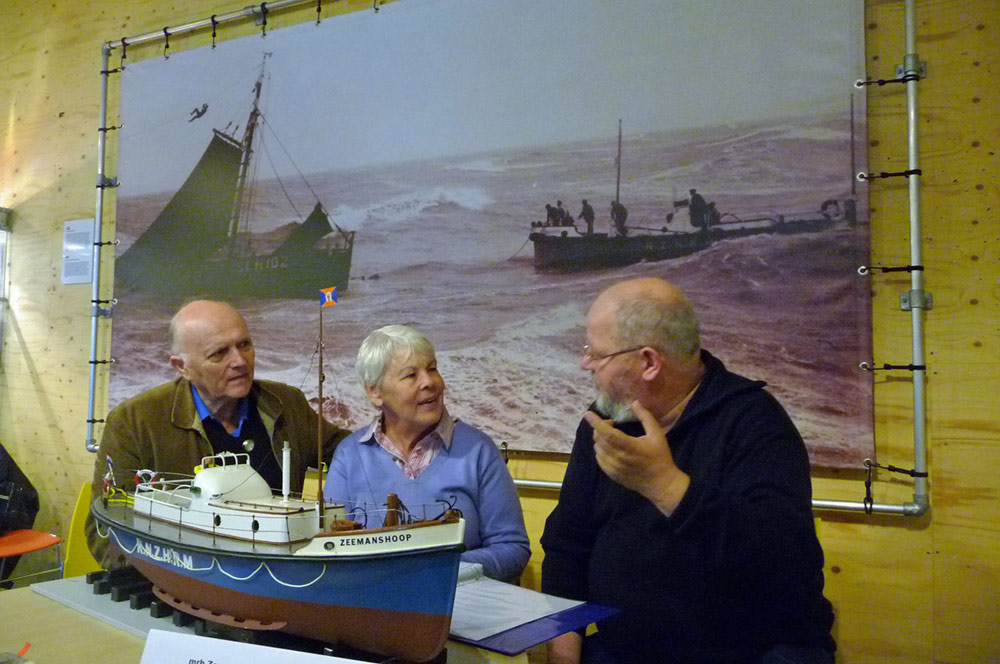
Lis Drew and her partner, John Staples, with Wybe van der Wal and a model of the Zeemanshoop at the Nationaal Reddingmuseum in Den Helder on 24 April 2012
Courtesy of Wout Smit
Acknowledgements
Too
many people have helped to mention them all here (their assistance is
acknowledged throughout the site) but the photograph of the Dutch lifeboat was identified as the Zeemanshoop by Allert M.A. Goossens,
a Dutch war historian, who crested the War over Holland web site and an
English language Forum. I would not have set out on this
quest to find out about the voage of the Zeemanshoop if Lis Drew, the grand daughter of Joop van der Laan, had not sent me
a translation of the well known account by De Booys in Between Mines
and the Deep Sea
plus a transcription of the names on the sea chart; Wybe van der Wal
maintains the dorusrijkers.nl web site on the history of Dutch
lifeboats including the Zeemanshoop;
Wout Smit researched the passengers names on Dutch web sites and lectured on the Zeemanshoop; Radboud Hack, the son of the "Captain", Harry Hack,
translated all known accounts of the voyage including his father's
previously unpublished account while Loet Velmans and Karel Dahmen both
alive today gave first hand descriptions of the voyage and patiently answered my many questions.
Bill Forster
Holywell House Publishing
They were able to take a short trip on the restored Dutch lifeboat which had saved the lives of their families 75 years ago
HMS Venomous could not be there but the Royal Navy sent HMS Trumpeter in her place
Read about HMS Venomous
, the Royal Navy destroyer which picked up the passengers and crew of the Zeemanshoop, in
A Hard Fought Ship: the story of HMS Venomous
The new hardback edition was published on 9 May 2017